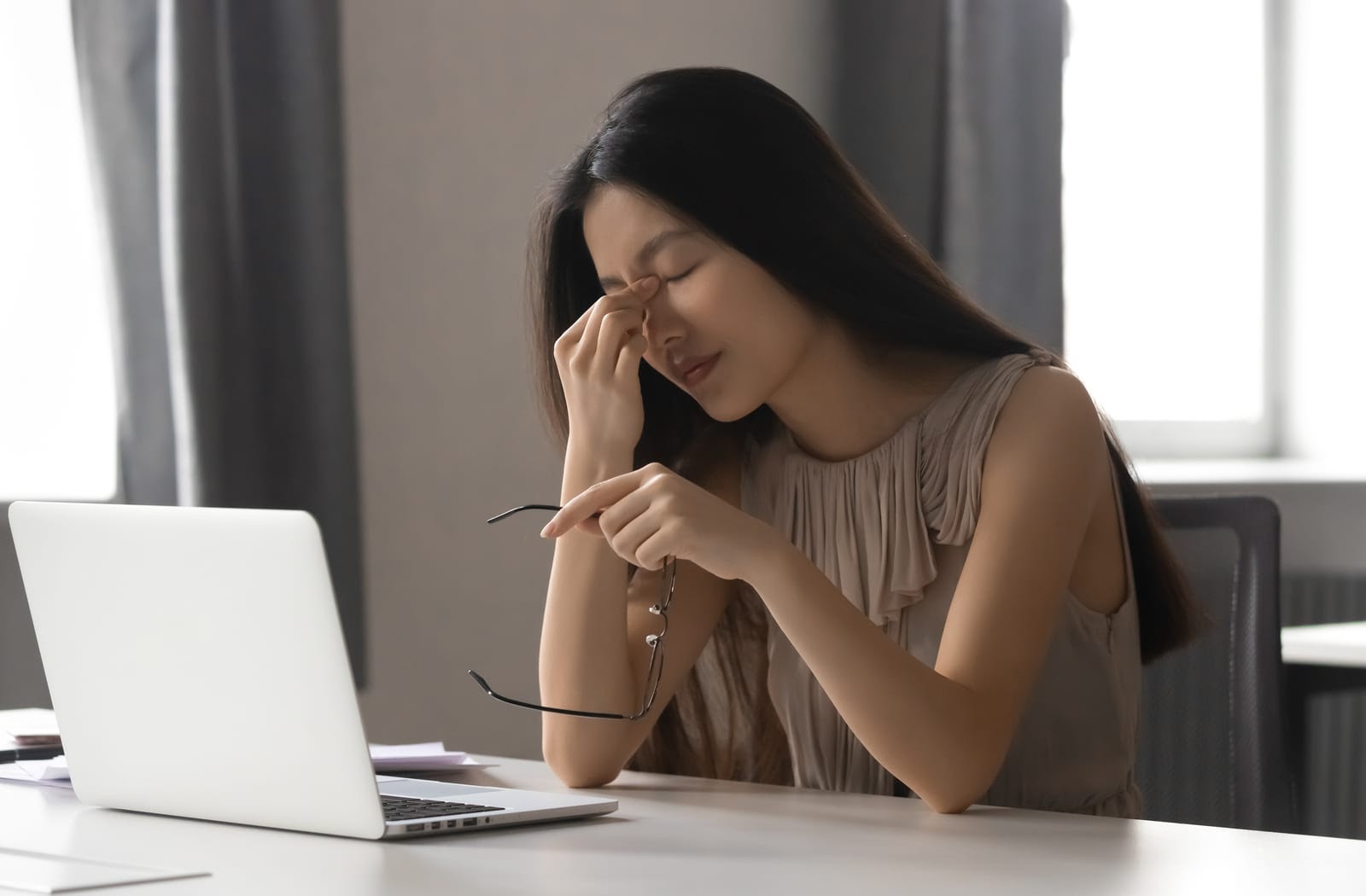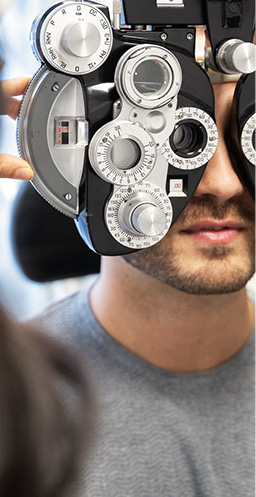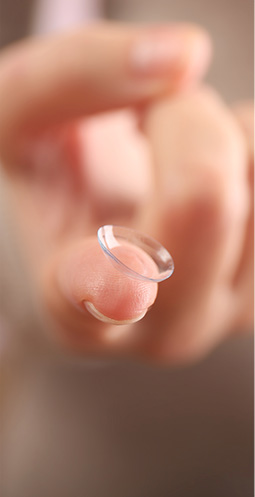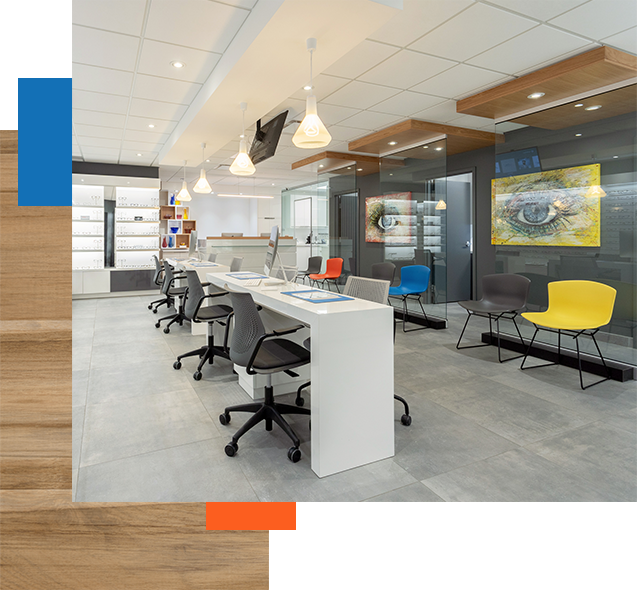Do you ever finish your workday and notice your eyes are dry and burning, your neck is stiff, and you just feel exhausted? The physical effects of working on a computer all day long can take their toll even beyond your working hours.
The good news is that there are lots of solutions available to relieve your dry eyes and make your neck and shoulders more comfortable throughout the workday. And many of them start with taking care of your vision.
Possible Causes of Dry Eye in Your Workplace
Digital Eye Strain
If you use a computer, tablet, and smartphone in your work, odds are you experience some degree of digital eye strain. Also known as computer vision syndrome (CVS), these dry eyes, headaches, blurred vision, and body aches affect up to 90% of people who use screens for work.
When we use computers, we blink about 50% less often than when we’re doing other tasks. At the same time, our backlit screens are emitting high-energy blue light, which scatters and makes our eyes work harder to focus. Screens tend to be lower-contrast than printed materials, which also causes eye strain.
Digital eye strain is made worse if your prescription isn’t up to date, or if your glasses or contacts aren’t designed for long hours at a computer. If it’s been a while since your last eye exam (most adults should have an eye exam at least every two years), this might be the perfect time to see if your prescription needs an adjustment to suit your lifestyle.
Other Possible Causes of Dry Eye at Work
Your work environment, whether it’s at home or in an office, could be making your dry eye symptoms worse. These environmental factors might include:
- Dry air: From heating or air conditioning, or the movement of air, such as a vent or fan blowing over your face
- Poor air quality: This could include dust, smoke, or chemicals
- Poor lighting: You need enough light to see everything clearly, whether on-screen or otherwise, but not so bright as to cause glare on your monitor
- An uncomfortable desk setup: Your chair, keyboard, monitor, and desk height all combine to keep you comfortable—or not. Even if you have an ergonomic setup, other factors like poor lighting may cause you to slouch or otherwise compromise your posture. Similarly, if your glasses prescription isn’t right for computer work, you might find you’re squinting, leaning, or tilting your head to see better, which can cause aches and pains over time.
Risk Factors for Dry Eye Syndrome
Your dry eyes are likely not caused entirely by your working environment. Most dry eye symptoms are a result of meibomian gland dysfunction (MGD). Your meibomian glands are responsible for secreting the oil (called meibum) required for healthy tears. MGD happens if the quality or quantity of your meibum is poor. This could be from blocked glands or because meibum has hardened within the glands.
Other risk factors for dry eye include:
- Age: Dry eyes naturally accompany aging
- Gender: Women are more likely to have dry eyes due to the hormonal changes in pregnancy and menopause, and from hormonal birth control
- Certain medications: Antihistamines, decongestants, blood pressure medication, and antidepressants can all affect tear production
- Certain medical conditions: Including diabetes, rheumatoid arthritis, and thyroid conditions
- Contact lens use: Long-term contact lens use can contribute to dry eye disease
- Recent LASIK: Dry eye is a very common after-effect of laser eye surgery, though it often resolves within six to 12 months of surgery
Solutions for Digital Eye Strain and Dry Eye at Work
There’s plenty you and your employer can do to create a more comfortable workspace and start to relieve your dry eye symptoms.
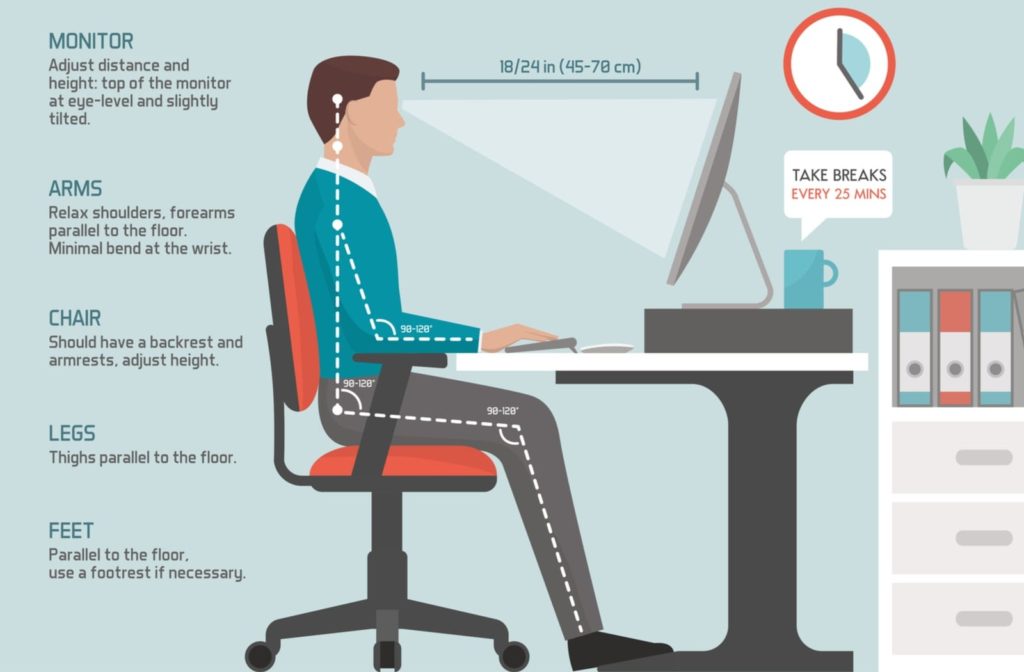
Create an Ergonomic Workspace
Refer to the illustration for workspace adjustments that can make a big difference on your symptoms. If you use a laptop, consider adding a separate keyboard so you can raise your monitor to an appropriate height while keeping your forearms parallel to the floor.
Don’t forget to adjust lighting to eliminate glare while ensuring your space is appropriately lit.
Take Breaks
Our eyes didn’t evolve for the office environment. You can give them a screen break by following the 20/20/20 rule: Every 20 minutes, take a 20-second break where you focus on something 20 feet (six metres) away. Set a reminder for yourself on your phone, if necessary. And don’t forget to blink regularly.
Sleep Well
Your eyes need a good night’s sleep to function at their best. When you don’t get enough sleep, you may notice:
- Your eyes feel tired, dry, and gritty
- You have trouble focusing your attention and experience blurred vision
- You’re extra light-sensitive
- Your eyes twitch
- You’re tempted to rub your eyes (it’s always best to avoid rubbing your eyes)
Book an Eye Exam
A comprehensive eye exam can reveal the cause of your dry eye symptoms and ensure your prescription is correct. You can also discuss blue blocking lens coatings or computer glasses with your optometrist to learn if they might be a good option for you.
Treatment for Dry Eye
If adjustments to your workplace haven’t relieved your dry eye symptoms, it may be time to talk to your optometrist about dry eye disease. Following an exam, your optometrist can recommend a series of treatments based on the cause and severity of your dry eye symptoms. Many of these treatments can provide lasting relief.
Medicated Drops
Artificial tears provide only mild, short-term relief from dry eyes. If appropriate, your doctor can prescribe an anti-inflammatory eye drop..
Heated Eye Masks
A moist heat eye compress can gently soften the meibomian oil glands to help stabilize your tear film and provide relief for dry eyes.
Lid Hygiene Wipes or BlephEx
For dry eyes that are a result of an eyelid inflammation called blepharitis, lid wipes can help clear bacteria and debris from around the lid margin. We can also offer a BlephEx treatment in-office to clean and exfoliate your eyelids.
Mibo Thermoflo
Mibo Thermoflo is an in-office treatment that warms and massages the eyelids to treat dry eye caused by meibomian gland dysfunction.
Meibomian Gland Expression
We’ll gently warm the eye area and then manually express your meibomian glands to help restore your tear quality.
Intense Regulated Pulsed Light (IRPL) Therapy
Intense regulated pulsed light uses precisely calibrated light pulses to treat chronic dry eye syndrome. Stoney Creek Eye Care is proud to be one of the few Canadian practices to offer this innovative, non-invasive dry eye treatment. Research has shown that the results of IRPL are expected to last a minimum of six months and up to three years or more.
What to do Next for Dry Eye Relief at Work
Regular eye exams are key to keeping your hard-working eyes comfortable and healthy.
If you’re experiencing discomfort during your workday, book an eye exam with us. You’ll be able to discuss your work environment with your optometrist and together, you can find relief for dry eyes and digital eye strain.


